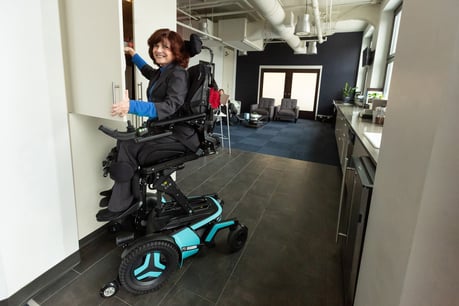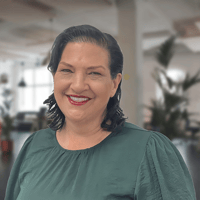Sound clinical justification and rationale must be articulated when prescribing assistive technology – essentially, we need to demonstrate clinical reasoning processes to the funding body when seeking financial support for mobility and seating equipment. This can be challenging for newer prescribing therapists especially when the solution has not been determined through the clinical reasoning processes.
Whilst there is often a clear pathway between mobility needs and the requirement of a mobility base, it is often the other functional aspects of participation and activity that require additional features within the mobility base that need to considered prior to a trial.
What is Clinical Reasoning?
“Clinical reasoning is not new to occupational therapy. Therapists have always engaged in clinical reasoning, and educators have always sought to teach students how to think like therapists.” (Neisdiat, 1996). Clinical reasoning relates to the thinking and decision-making processes which take place in relation to clinical practice (Higgs and Jones 2000) It is the foundation for all occupational therapy interventions, a dynamic process that develops and evolves alongside our practice.
Clinical reasoning can differ between therapists of different levels of experience, Allied Heath students tend to use a more analytic way of reasoning, where they seek answers from their theoretical knowledge to explain their findings, while more experienced therapists tend to rely on patterns they recognise without full analytical thought process, however experienced therapists will engage in an analytical thought process when presented with something unfamiliar (Gummesson, Sunden and Fex 2018).
How Clinical Reasoning Develops
Dutton describes 5 levels of learning in relation to clinical reasoning development. Let’s take a closer look at these stages and what that means in relation to equipment prescription in particular the trial.
Novice – This is our first experiences into clinical reasoning and is based on the foundation models and clinical principals that guide intervention. In other words, we understand the model or approach and potentially have the skills and theoretical concepts but will follow the model as rules, ask every question on the assessment form – eg. asking someone with a complete SCI at a mobility assessment if they can walk because there is a box on the assessment form asking this question.
Advanced Beginner – This is the level of Clinical Reasoning we may have reached as a new graduate or in our first years of practice. Here we begin to modify rules and principles for specific situations (Dutton) – in other words, we begin to implement situational thinking but still need to develop how the assessment information is prioritised. Pre-trial assessment may have included components of the bio-mechanical MAT assessment of the joints that appear to be restricted – if someone can’t achieve full passive ROM in any of these joints it may still be viewed as a problem even if it is not impacting that person’s seated postural and functional needs. During the trial an advanced beginner clinical reasoner may identify potential issues for their client but rely heavily on the suppliers input to addresses potential options.
Competent – The competent clinical reasoner is able to adjust practice based on the situation. They can identify the relative importance of different pieces of information about a client but may still have difficulty altering the intervention plans or seeing how changes will impact on posture. In a trial they may experience difficulty in understanding the impact of different sized chairs between the trialled option and the prescribed size or configuration. The clinical reasoning may have been (as it should) prior to the trial but at the trial itself they may struggle to making a decision that modifies the anticipated outcome.
Proficient – The proficient therapist has the flexibility to alter plans as needed throughout the process or intervention. The proficient therapist can easily identify how configuration can impact on the access and functional mobility and can trial slightly different size or configuration and still identify features to ensure best outcomes even if the exact set up is unavailable to trial. They can articulate clinical justifications based on the assessment and observations from trial.
Expert – The expert prescriber tends to take cues from the client rather than needing to follow a set plan. They can make on the spot changes to the initial plan and can identify and adapt information to reach best outcome. Experts are able to recognise client problems and potentials quickly on the basis of their recognition of patterns from previous clinical experiences.
We move through these stages as our clinical skills develop, based on our experiences and level of reflective practice. If working within different scopes, we may also demonstrate different levels of clinical reasoning for different areas of practice. Time taken to work through the stages varies within scopes and complexity.

When we conduct a seating and mobility assessment we apply clinical reasoning to determine potential options. There is a major difference in the funding processes between New Zealand (NZ) and Australia. In NZ, the clinical justifications are submitted based on the clinical assessment, potential solutions that meet the clinical needs are identified. Once the funding body has determined that the clinical justifications meet criteria, approval is given to trial the specific equipment the therapist has identified.
In Australia the system remains that the funding application is submitted after the trial. Regardless of where in the process the clinical justification is submitted to a funding body, the assessment and trial still have the same purposes and follow the same processes. The clinical reasoning process begins as we collect information and complete our evaluation and guides us to the selection of specific equipment parameters.
The clinical justifications and equipment parameters should be determined before a trial. The purpose of a trial is to confirm specifics around those features and ensure the expected outcomes are met. Evidence of how the outcomes are met come from the functional tasks completed at trial.
For those therapists that are at the early stages of prescription experience, there are lots of opportunities to develop your clinical reasoning; ongoing education, supervision, mentorship and experience. For the more experienced therapists, having a student on placement or providing mentorship can not only assist our newer therapists but assist in your own clinical reasoning development. Our Permobil education team are here to support you so if you want further support, please don’t hesitate to reach out to us at education.au@permobil.com
References
Gummesson, C., Sunden, A., & Fex A. (2018). Clinical reasoning as a conceptual framework for interprofessional learning: a literature review and a case study. Physical Therapy Reviews 23 (1) 29-34
The development of clinical reasoning follows a continuum through the following stages: novice, advanced beginner, competent, proficient, and expert (Benner, 1984; Dreyfus & Dreyfus, 1986; Dutton, 1995; Slater & Cohn, 1991).
Neistadt, M (1996) Teaching Strategies for the Development of Clinical Reasoning. American Journal of Occupational Therapy, September 1996, Vol. 50, 676-684.

Tracee-Lee Maginnity
Clinical Services Specialist
Permobil APAC
Tracee-Lee Maginnity joined Permobil Australia in July 2019, as a clinical education specialist. Originally from New Zealand, she graduated Auckland University of Technology with a BHSc (Occupational Therapy) in 2003 and has since worked in various roles related to seating and mobility including assessing, prescribing and educating. After gaining experience as an assessor and prescriber at Seating To Go / Wheelchair Solutions in prescribing for both disability and injury, she moved to Australia in 2011 to take on the Senior Occupational Therapist role in a custom moulded seating service. She then worked in clinical consulting and education roles until joining Permobil.
Tracee-Lee is passionate about maximising functional outcomes with end users and the importance of education within the industry. She has mentored many therapists interested in AT. Her experience includes working with complex postures to achieve custom outcomes. Tracee-Lee is also an international wheelchair rugby classifier where she enjoys the task analysis of wheelchair propulsion and functional capacity identification of athletes.
